Bala sharks are large freshwater fish with social and peaceful temperaments. These active swimmers frequently form shoals in community aquariums. The key to maintaining bala sharks as pets is keeping them only with compatible tank mates. Even peaceful fish species like the bala shark cannot live with just any aquarium fish.
Considering the tank mates’ size, social behavior, diet, and temperament is important before keeping them with bala sharks. Most bala sharks pair well with other tropical fish similar in size as long as the tank conditions can support both species.

A Quick Overview of Bala Sharks
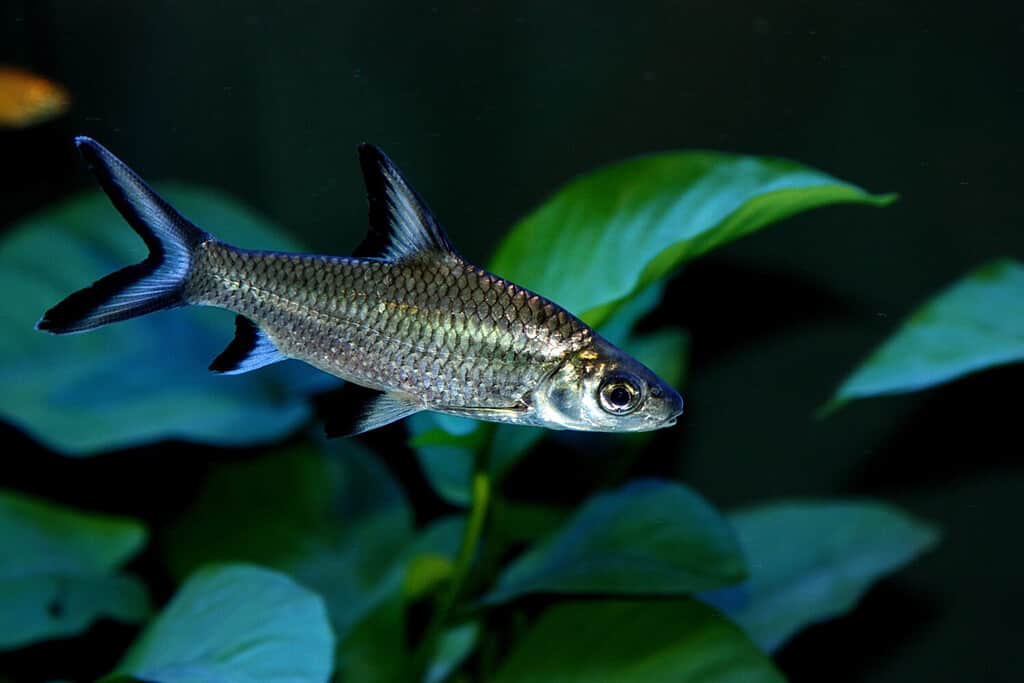
Bala sharks are freshwater fish that have silver iridescent bodies and dark markings on their fins.
©Arunee Rodloy/Shutterstock.com
| Scientific name: | Balantiocheilos melanopterus |
| Origins: | Southeast Asia |
| Adult size: | 10 – 14 inches |
| Lifespan: | 6 – 10 years |
| Temperature: | 72° – 82° Fahrenheit (22° – 27° Celsius) |
| Diet: | Omnivore |
| Minimum tank size: | 125 gallons |
| Sociability: | Needs to be kept in groups of five or more. |
Bala sharks originate from the tropical southeast Asian waters, where they inhabit fast-flowing streams and rivers. Despite their name, they are not a true shark species and are one of the two members of the Balantiocheilos genus. Bala sharks are known in aquariums for being shy and easily stressed, although they still make good pets. They are sensitive to sudden changes in their environment and do not do well in poor quality. Their large size and specific water conditions make them challenging to keep. For these reasons, they are better suited for more experienced fish keepers.
Choosing The Right Tank Mates for Bala Sharks
You should only move on to considering tank mates once the bala shark’s care requirements are met. Bala sharks need spacious fish tanks equipped with a filter and a heater to replicate tropical conditions. They require spacious aquariums over 125 gallons in size. As peaceful and highly social fish, bala sharks must be kept in groups of five or more to encourage shoaling behavior.
The right tank mates for bala sharks will be other large and peaceful freshwater fish that can thrive in the same conditions as them. Their tank mates should be large enough not to fit into a bala shark’s mouth. Bala sharks can grow up to 14 inches long and have no trouble preying on smaller fish like neon tetras.
Furthermore, bala sharks can become stressed if aggressive fish chase and bully them. Also, avoid keeping them with fish with long fins, as bala sharks may nip at them. When kept in proper conditions, bala sharks are active and enjoy swimming around the aquarium. This movement may bother slow-moving fish, so it’s also best to avoid these types of tank mates.
The Best Tank Mates for Bala Sharks
We look at the 12 best tank mates for bala sharks below!
1. Black Ghost Knifefish (Apteronotus albifrons)
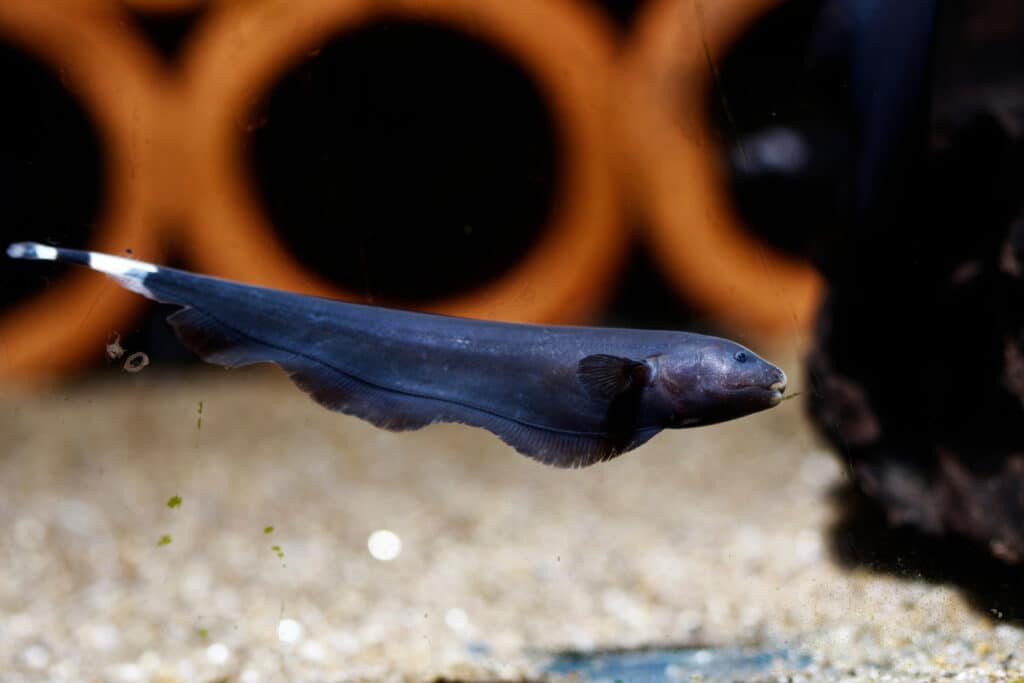
Black ghost knifefish produce electric fields to help them navigate their environment.
©Pavaphon Supanantananont/Shutterstock.com
The black ghost knifefish is a unique-looking aquarium fish that resembles an eel. Their bodies are a striking black coloration with white rings along their tail. They lack dorsal and caudal fins and instead have an elongated anal fin and a pair of pectoral fins. Black ghost knifefish typically grow between 14 to 18 inches long and require a spacious aquarium over 100 gallons in size. When kept with bala sharks, the tank must be well over 150 gallons and fully cycled.
Their natural habitat consists of sandy rivers with fast-moving currents, which owners should replicate in the aquarium. They are highly sensitive to poor water quality, which can make them ill, so pristine water conditions are crucial for their health.
Black ghost knifefish are nocturnal so they will be more active during the night. They usually keep to themselves in an aquarium and won’t interact with bala sharks much unless they feel disturbed.
2. Clown Loaches (Chromobotia macracanthus)
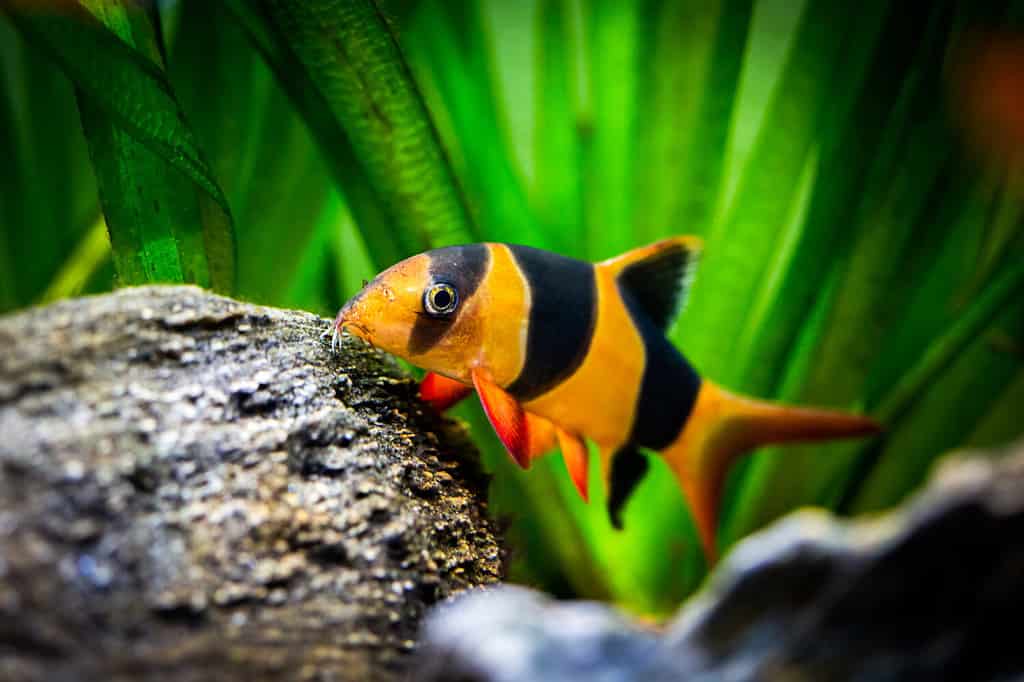
Clown loaches have banded bodies with red fins, making it seem like they are wearing clown suits.
©Joan Carles Juarez/Shutterstock.com
The striped and red-finned clown loach is a large bottom-dwelling fish from southeast Asia. Clown loaches grow to around 8 inches long, although they usually grow to 6 inches in captivity. These peaceful shoaling fish need to be kept in groups of five or more. Keeping them in same-specie groups allows clown loaches to be more active and feel safer in aquariums. Like bala sharks, clown loaches need good water quality to be healthy and happy. Poor water quality may make them more susceptible to disease, often fatal to these sensitive fish.
3. Emerald Rainbowfish (Glossolepis wanamensis)
Emerald rainbowfish are mesmerizing in aquariums with their iridescent greenish-yellow bodies. They are a critically endangered fish species in their native habitat – Lake Wanam in Papua New Guinea. However, emerald rainbowfish are part of the aquarium trade industry, where they make colorful additions to freshwater aquariums. They are relatively small fish at only 4 inches in size and require a minimum of 30 gallons.
Emerald rainbowfish require neutral-to-slightly-alkaline tropical waters. Proper care and a healthy omnivorous diet allow the emerald rainbowfish to be active and boisterous in aquariums. Like most rainbowfish, the emerald rainbow thrives in heavily planted setups with plenty of space to explore.
4. Tiger Barbs (Puntius tetrazona)
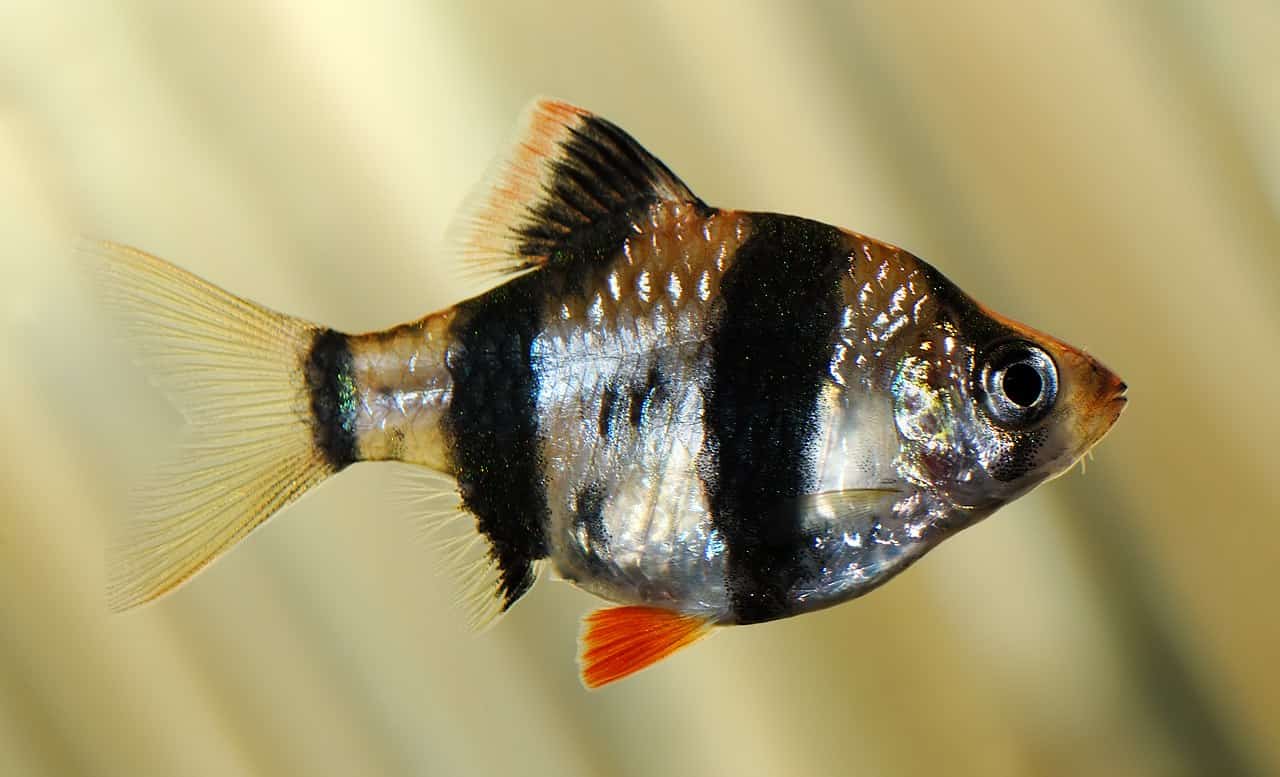
Tiger
barbs are small tank mates that pair well with bala sharks. They grow 3 inches long.
©André Karwath aka Aka, CC BY-SA 2.5, via Wikimedia Commons – License
The active and social tiger barb is a schooling fish that grows 2 to 3 inches long. Tiger barbs have black and golden-orange striped bodies paired with red markings on their face and fins. Other variants of tiger barbs include the albino and green tiger barbs, which have varying appearances.
Fully grown tiger barbs can live with bala sharks. In adulthood, they are usually not small enough for bala sharks to eat them. You must keep tiger barbs in groups of six or more because they are highly social. A heater and good filtration system are important for tiger barbs because they need tropical conditions and good water quality to thrive.
5. Gold Nugget Plecostomus (Baryancistrus xanthellus)
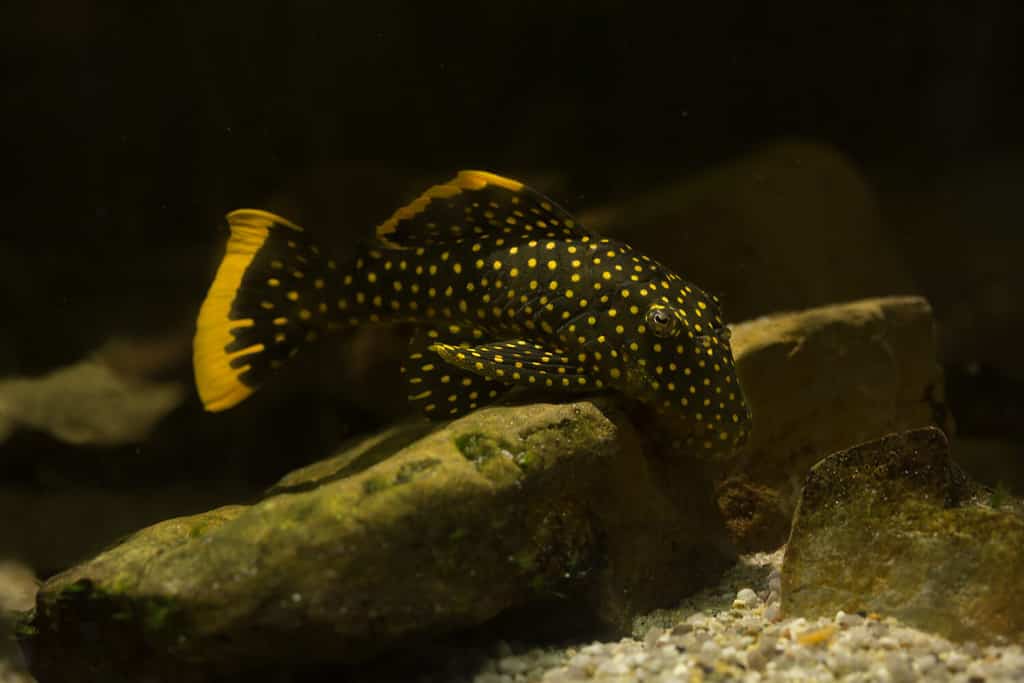
The popular gold nugget pleco has striking yellow markings, making it stand out in aquariums.
©Podolnaya Elena/Shutterstock.com
Gold nugget plecos are bottom-dwelling fish that also go by gold spot plecos. These suckermouth catfish originate from South American waters in Venezuela and Brazil. Gold nugget plecos are one of the more colorful species of Plecostomus that are easy to distinguish.
They have a predominantly black body paired with whiteish-yellow spots and markings on their fins. These Plecostomus grow 7 to 10 inches long, requiring a spacious tank over 75 gallons in size. Gold nugget plecos prefer a solitary lifestyle and do not need to be kept in groups. They rarely interact with bala sharks in the aquarium who swim at different water levels.
6. Tinfoil Barbs (Barbonymus schwanenfeldii)
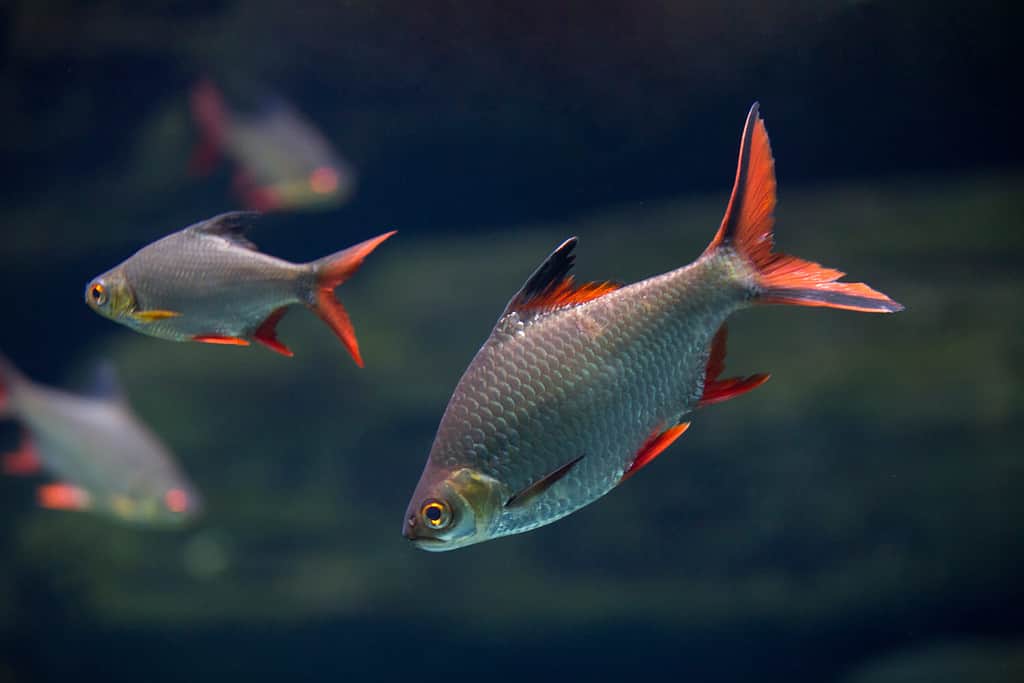
Tinfoil barbs can grow up to 14 inches long, similar to bala sharks.
©ivSky/Shutterstock.com
The tinfoil barb is a species of freshwater fish native to Southeast Asia. They are one of the larger species of barbs at 10 to 14 inches long and have peaceful temperaments. Their water conditions, temperature, and size are similar to bala sharks, making them compatible tank mates.
Tinfoil barbs thrive in tropical temperatures with good water quality. Their tank should be spacious at over 175 gallons long when kept with bala sharks. Tinfoil barbs should be kept in groups of five or more to form a shoal. They are easily stressed alone and do not do well in pairs, even if they are kept with different fish species.
7. Blood Parrot Cichlid
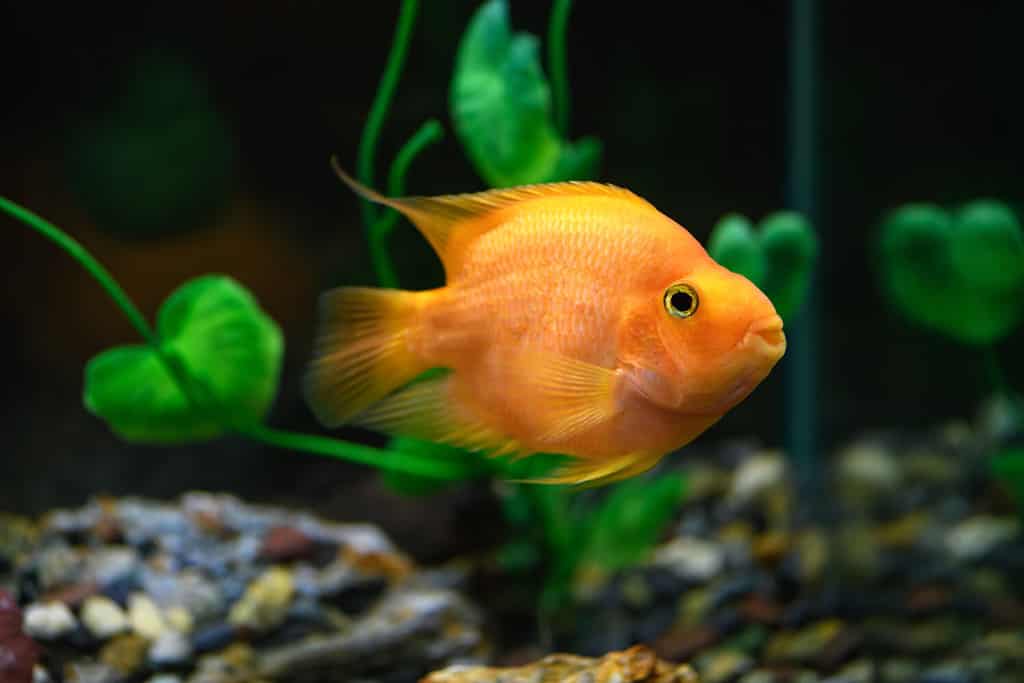
No blood parrot cichlids are in the wild because they are man-made fish.
©Bk87/Shutterstock.com
The blood parrot cichlid is a freshwater fish that does not have a scientific name yet. However, they are classified as cichlids because they belong to the Cichlidae family. Blood parrot cichlids are a hybridized fish created in Taiwan in 1986.
Their distinctive yellowish-orange coloration makes them easily recognizable in aquariums and grows to around 8 inches long. Blood parrot cichlids display fascinating behaviors in aquariums that effortlessly prove their intelligence.
Nest-building is one of the blood parrot cichlids’ favorite hobbies, and they take pride in constructing crater-like nests on sandy or gravel substrate. Blood parrots may swim up to the glass when you approach the aquarium in hopes of getting fed.
Bala sharks and blood parrot cichlids can coexist peacefully in the same aquarium if it is over 150 gallons in size. Although it is preferred, you do not need to keep blood parrot cichlids in groups.
8. Angelfish (Pterophyllum scalare)
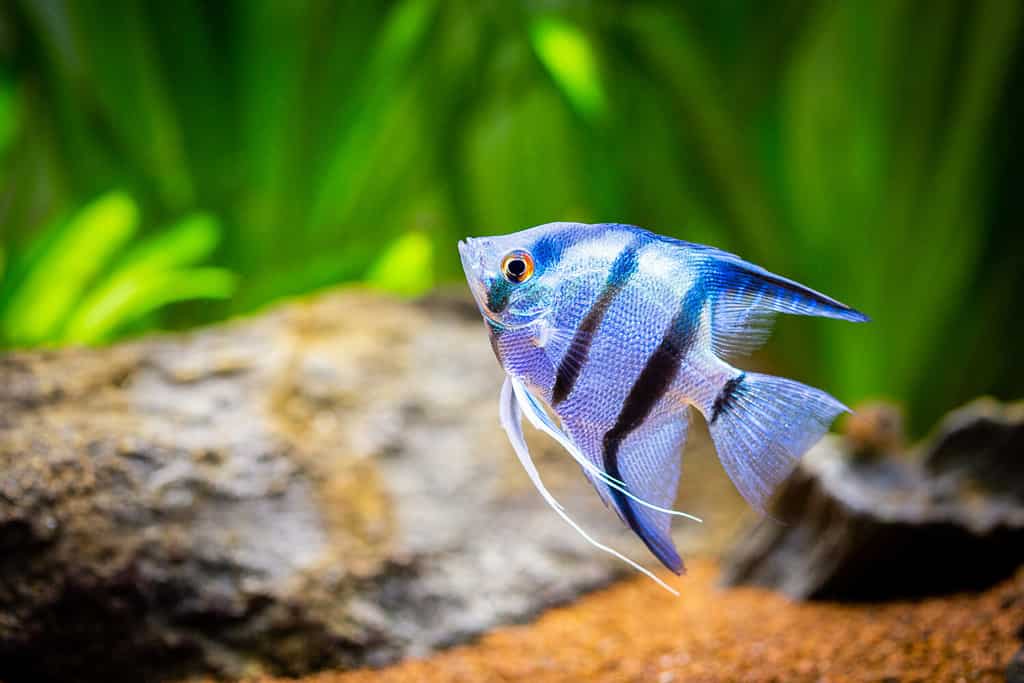
Angelfish
can be found in various colors and patterns, such as striped or black.
©Joan Carles Juarez/Shutterstock.com
Freshwater angelfish are some of the most popular schooling fish in the world. These fish originate from South America in the Amazon and Orinoco River Basins. An angelfish’s body is compressed, and their most noticeable features are their elongated dorsal and anal fins. Adults grow 5 to 6 inches long, but some species only reach 2 inches. However, because of their size, the P. scalare species is better suited as a tank mate for bala sharks.
Only adult angelfish over 4 inches in size should be kept with bala sharks to prevent predation. Angelfish are available in various colors and patterns, with black lace, leopard, and koi being popular. These relatively peaceful fish keep to themselves in an aquarium and enjoy swimming in groups of six or more. They are active in the right conditions and form schools of their species.
9. Kissing Gourami (Helostoma temminckii)
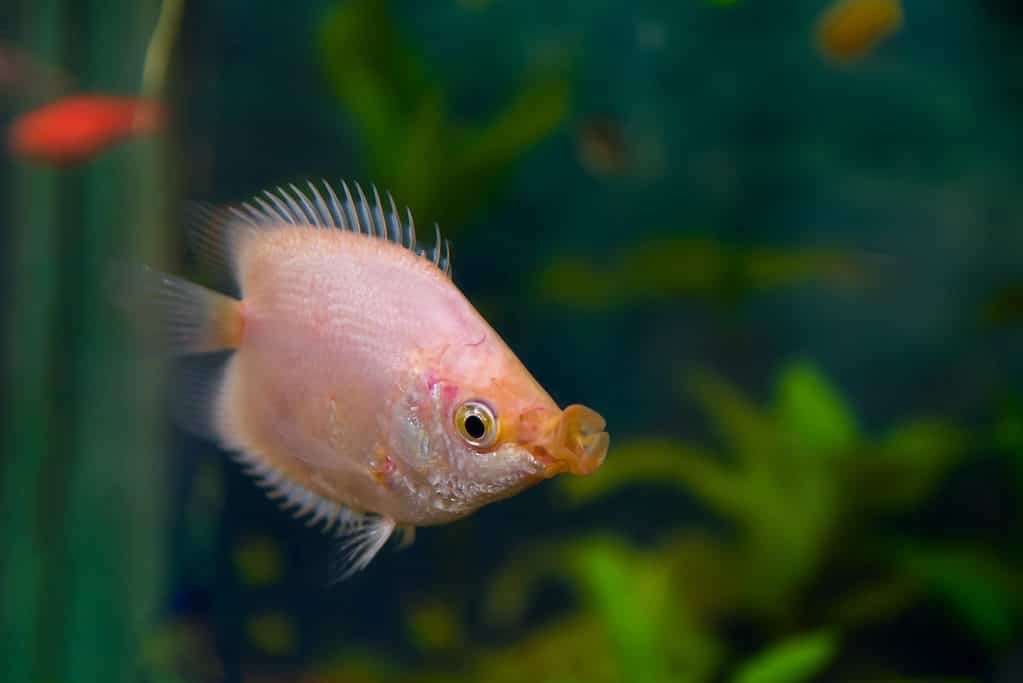
The kissing gourami is one of the most distinct species due to their protruding mouths.
©Evgenii Predybailo/Shutterstock.com
One of the most interesting gourami species is the H. temminckii, or kissing gourami. They earn their name from their protruding mouths that they use to lock against other kissing gouramis during ritualized fights.
Aside from their unusual mouths, kissing gourami are recognized by their iridescent greenish-silver bodies. They have the opportunity to grow very large in aquariums, up to 12 inches long, but they usually grow half that size. This is why they should only be kept in spacious aquariums with a good filtration system.
Kissing gourami can be territorial and aggressive, but they usually get along with bala sharks. They are comfortable at the same temperature range as bala sharks, 72° to 82° Fahrenheit.
10. Boesemani Rainbowfish (Melanotaenia boesemani)
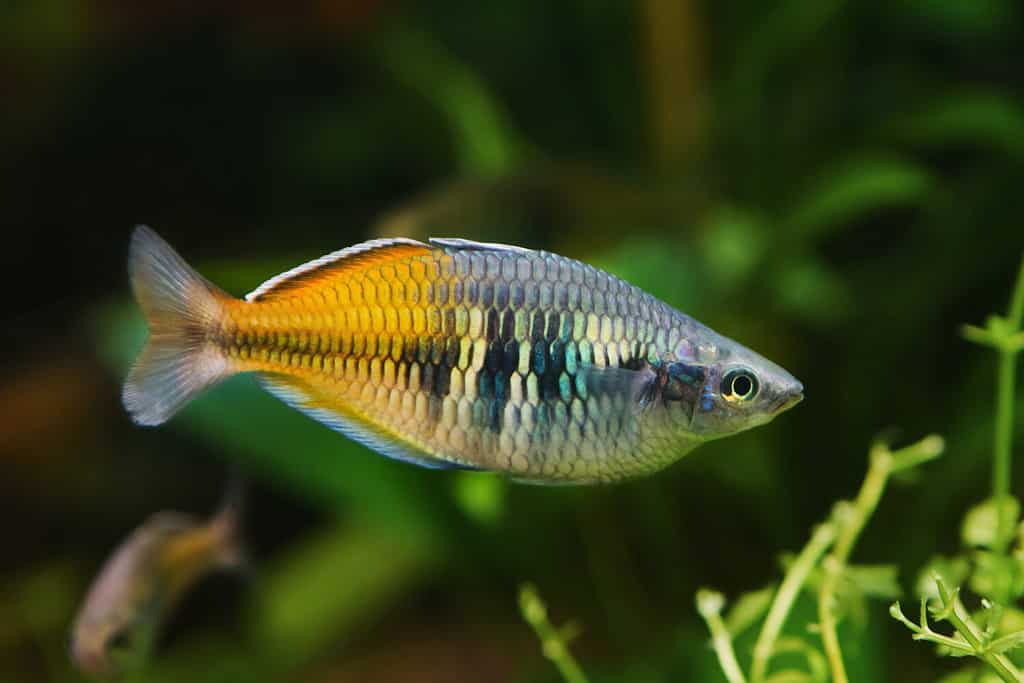
The ideal temperature range for boesemani rainbow fish is 75° to 86° Fahrenheit, so they need a heater.
©Aleron Val/Shutterstock.com
One of the most colorful tank mates for bala sharks, are boesemani rainbowfish endemic to the Ayamaru Lakes in Papua New Guinea. Boesemani rainbowfish have striking yellow and silver iridescent bodies that stand out in aquariums. Most boesemani rainbowfish grow to 4.5 inches long but can reach 6 inches.
They are social fish that enjoy being kept in groups of six or more so that they can form shoals. You will need to keep them in groups in a bala shark aquarium and ensure their conditions are ideal for them to thrive. Boesemani rainbowfish are strictly tropical fish that should be kept in heated aquariums. Their natural habitat can reach 100 degrees Fahrenheit, so boesemani rainbowfish have adapted to hot conditions.
11. Silver Dollars (Metynnis argenteus)
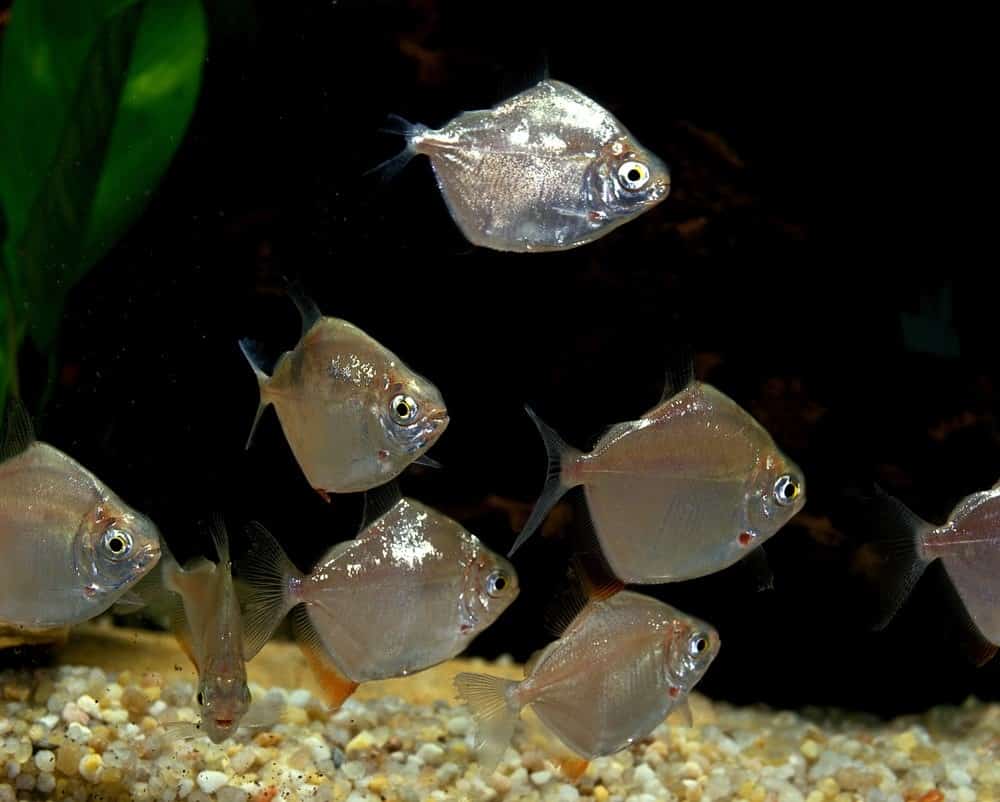
Keeping silver dollars in groups of five or more would be best because they are schooling fish.
©slowmotiongli/Shutterstock.com
The silver dollar is named after its laterally compressed bodies and shiny grey or silver coloration. These fish are native to South America and inhabit the Orinoco and Amazon River Basins.
Different species of silver dollar fish belong to the Metynnis and Myloplus genus. However, the Metynnis argenteus species is the most popular and can be kept with bala sharks. You can get striped, spotted, and red hook silver dollars, too, which can also be a good tank mate for bala sharks.
Fully grown silver dollars are 6 to 8 inches long, requiring a spacious filtered and heater tank. Aim to keep the tank size above 150 gallons with bala sharks since both fish benefit from plenty of swimming room. Like bala sharks, the silver dollar fish should be kept in groups of five or more. Although they are relatively mellow fish, silver dollars can show signs of semi-aggressive behavior like chasing.
12. Banded Severum Cichlid (Heros severus)
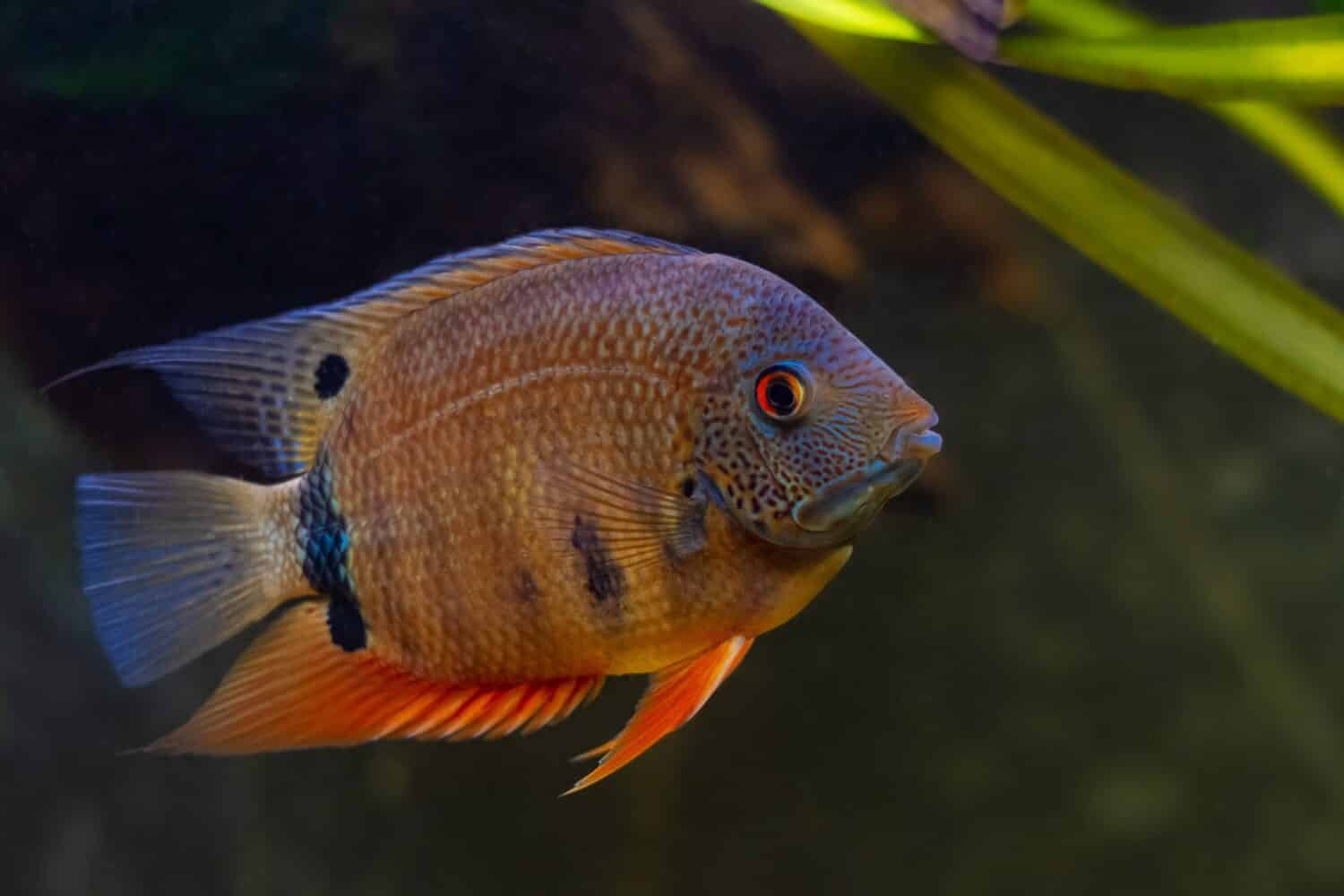
Several species of severum cichlids range in color, but the
H. severusis the most popular.
©Aleron Val/Shutterstock.com
Banded severum cichlids are a more peaceful cichlid species originating from South America. They grow to around 8 inches long and have dark vertical bands across their bodies. These bands usually fade as they age, and it is most visible in juveniles.
Banded severum cichlids are different colors, such as red-spotted, gold, silver, green, and maroon. Their exact coloration depends on their species, although the H. severus is the most common species in aquariums. They can liven up bala shark aquariums and add a dash of color. You can keep banded severum cichlids in the same conditions as bala sharks, as both species need a large tank, filter, and heater.
Conclusion
There are many different tank mates you can successfully pair with bala sharks. Some of the most popular bala shark tank mates are gold nugget Plecostomus, clown loaches, and tinfoil barbs. The most important consideration to keep in mind when housing bala sharks with other fish is that the tank needs to be incredibly large. If you want them to thrive, you need the space and time to maintain a large aquarium for bala sharks.
Summary Of The 12 Best Tank Mates for Bala Sharks
| Rank | Tank Mate |
|---|---|
| 1 | Black ghost knifefish |
| 2 | Clown loaches |
| 3 | Emerald rainbowfish |
| 4 | Tiger barbs |
| 5 | Gold nugget Plecostomus |
| 6 | Tinfoil barbs |
| 7 | Blood parrot cichlids |
| 8 | Angelfish |
| 9 | Kissing gourami |
| 10 | Boesemani rainbowfish |
| 11 | Silver dollars |
| 12 | Banded severum cichlid |
The photo featured at the top of this post is © smspsy/Shutterstock.com
Thank you for reading! Have some feedback for us? Contact the AZ Animals editorial team.







